اپنی تحریر بھیجیں۔
Saturday, November 28, 2015
Friday, November 20, 2015
Tuesday, November 17, 2015
Why is Pakistan's army chief all over social media?
Is the army general more popular than the prime minister in Pakistan and what does that means for democracy? BBC Urdu's Amber Shamsi investigates.
Just off the main road between the political capital and army headquarters lies a ramshackle set of houses.
They're new builds but shoddily constructed. The mosque is no different.
But it has a grand title - it has been named after Pakistan's current army chief General Raheel Sharif.
"We want General Raheel Sharif to help us catch the land grabbers and land mafia," says a young bearded man on his way to prayers.
Many Pakistanis seem to see General Raheel Sharif as a messiah who is saving the country from terrorism, corruption and all manner of social ills.
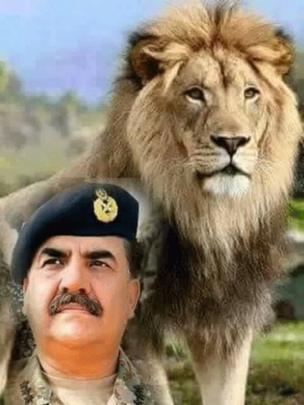 Image copyrightSocial media
Image copyrightSocial media
Wizened truck-art painter Habibur Rehman is one of them.
He has been decorating trucks in the traditional Pakistani way since 1955, where intricate patterns of flowers and birds are combined with political messaging.
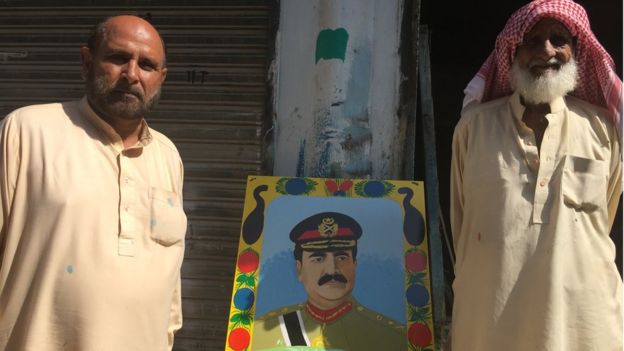
I ask him who his favourite leaders are.
"Benazir Bhutto is my all-time favourite," he says, swiftly mentioning her father Zulfiqar Ali Bhutto as his number two choice.
He then lists former presidents and military rulers Generals Ayub Khan, Zia-ul Haq and Yahya Khan.
I ask whether General Raheel Sharif makes the cut.
He raises his hand as if to the sky.
"Given the demand for him now and if he keeps performing well as a leader, he could even surpass the other five."
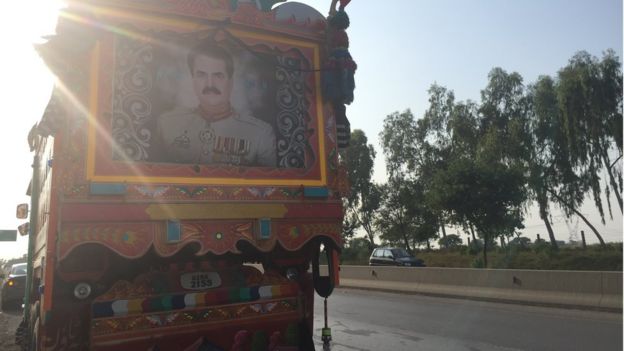
All about Raheel
General Raheel Sharif is neither a prime minister nor president but his image is popping up across the country.
He appears in banners thanking him for restoring law and order in the chaotic city of Karachi, on the backs of rickshaws and his image has even been used by politicians running for local elections.
The general has also gone digital with the hashtag #ThankYouRaheelSharif appearing on Twitter and Facebook.
The hashtag first appeared after the attack on an army-run school in Peshawar on 16 December 2014.
The army chief seemed to lead the effort to catch and punish the militants responsible for killing 150 people, mostly schoolchildren.
Facebook pages, Twitter handles and memes praising General Sharif are now commonplace.
One mockingly shows Prime Minister Nawaz Sharif, President Mamnoon Hussein and General Raheel Sharif sitting together, all with thought bubbles over their heads.
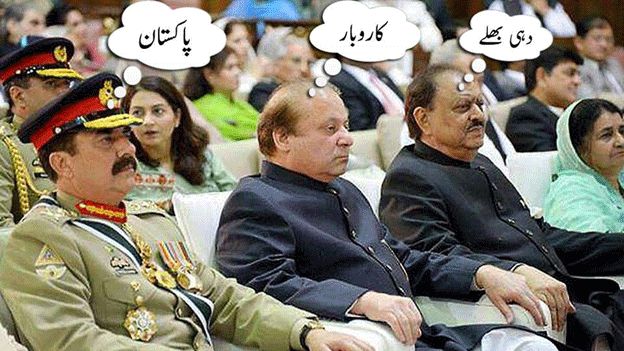 Image copyrightSocial media
Image copyrightSocial media
President Mamnoon is thinking of a snack, Prime Minister Nawaz Sharif is concerned with business while the general is thinking of Pakistan.
In a recent cover story on the personality cult of General Sharif, published in The Herald news magazine, journalist Umer Farooq asks whether such campaigns are being deliberately orchestrated.
He quotes Brigadier AR Siddiqi, a former official in the army's public relations arm, the Inter-Services Publicity Relations (ISPR), who says such image building often "happens under official direction and with the full weight of the state authority".
The ISPR denies this.
But Umer Farooq says the personality-led focus of the campaign gives the army a "political colour" which is beyond the role and function of a professional army.
Social satire
And where there is reverence online, there will also be mockery.
One producer at a TV channel took it upon himself to document the minutiae of his day based on the hashtag.
"On my way to work, all the traffic lights were green. #ThankYouRaheelSharif."
One satirical twitter account @DrMajorlyPhD recently wrote: "Watched Mad Max Fury Road. The story is bizarre but the movie is fantastic!! #ThankYouRaheelSharif".
But supporters on Twitter want an end to the "lame jokes" about the hashtag and have reported them by tagging the ISPR's director general Lieutenant General Asim Bajwa.
It is under his leadership that the army's publicity offerings - dramas, music videos and documentaries - have come to dominate the mainstream media landscape.
He was recently promoted from Major General to Lieutenant General.
In the army town of Rawalpindi, I meet Malik Mohammad Yousaf who has his car covered with giant posters of General Sharif.
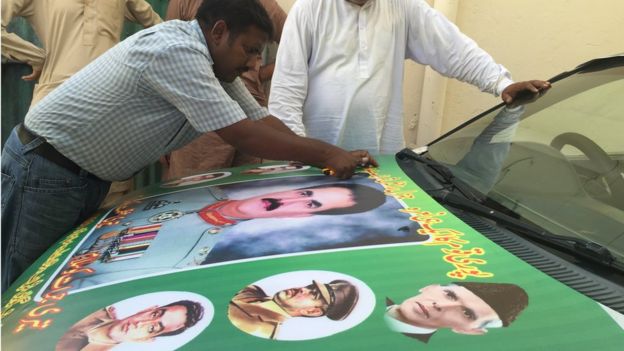
The general is set to retire next year and Mr Yousaf, who describes himself as a "disillusioned worker" in Prime Minister Nawaz Sharif's party, says the general's term must be extended to continue the fight against terrorism.
This call has been echoed on social media.
And there is a precedent.
The previous incumbent, General Ashfaq Pervez Kayani, had his term extended without a social media campaign or public support.
But Ahmed Bilal, the president of the Pildat think-tank which promotes democracy, believes such talk weakens Pakistan's fragile civilian and democratic institutions.
He says Pildat opinion polls consistently show that Pakistanis no longer want military dictatorships despite supporting the army.
"A distinction needs to be made: military commanders are very popular but not as possible replacements for the current political leadership," said Mr Bilal.
But as Mr Yousaf lovingly oversees the final touches to his car, he has harsh words for politicians.
"If they continue like this, martial law is a better option."
Thursday, November 12, 2015
59 most powerful images in Pakistan's history
A powerful image can take us back in time, and give us a better understanding of who we are and where we come from. The Express Tribune has compiled 59 images that have shocked, inspired, and moved us as a nation. Enjoy.
August 1947 – Quaid-e-Azam Muhammad Ali Jinnah in Karachi

As slogans of “Quaid-e-Azam Zindabad! Pakistan Zindabad!” echoed, Jinnah along with his sister, Fatima Jinnah, on August 7, 1947, landed in Karachi — a week before Pakistan became recognised as a separate nation.
August 1947 – Pakistan gains independence from India

Quaid-e-Azam Muhammad Ali Jinnah’s hard work paid off when Pakistan was announced as an independent state for Muslims of the subcontinent. Following its creation as a new country, Pakistan applied for membership of the United Nations and was accepted by the General Assembly on September 30, 1947.
August 1947 — Transfer of power

PHOTO SOURCE: HISTORYPAK
Jinnah delivers a speech on the occasion of Transfer of Powers at Constituent Assembly of Pakistan. Lord Louis Mountbatten on August 14, 1947, appointed Jinnah as Governor General of Pakistan and transferred all powers to him. Fatima Jinnah and Edwina Mountbatten were also present at the ceremony.
August 1947 – Muslims leave for Pakistan

With about 10 million people migrating to Pakistan in what was called the largest mass migration in human history, as many as one million civilians died due to riots and internal conflicts.
September, 1948 – Quaid-e-Azam Muhammad Ali Jinnah passes away

PHOTO SOURCE: I OWN PAKISTAN
Suffering from tuberculosis, Jinnah’s health began to deteriorate and had to be flown from his residence in Ziarat to Karachi. He was brought into the city on September 11, 1948 where he succumbed to his health and passed away later at night.
1951 – Rana Liaquat meets Walt Disney

PHOTO SOURCE: DYNAMIC DIARIES
Pakistan’s first Prime Minister, Liaquat Ali Khan’s wife, Rana Liaquat met the famous American film-maker and animator, Walt Disney in Washington DC. She was accompanying her husband to an official tour to the United States. Rana was one of the leading female figures in the Pakistan Movement.
May 1955 — Second constituent Assembly

PHOTO SOURCE: HISTORYPAK
The second Constituent Assembly of Pakistan was created on 28th May, 1955. The strength of the Assembly was 80 Members, half each from East Pakistan and West Pakistan. It was under this Constitution that Pakistan became an Islamic Republic.
October 1958 — Constitution abrogated; Martial Law imposed

On October 7, 1958, President Iskander Mirza abrogated the Constitution and declared Martial Law in the country. As soon as the announcement was made, army units immediately captured all sensitive points and buildings in Karachi.
1959 – Pakistan’s first international gold medal in athletics

PHOTO SOURCE: YOUNG PAKISTAN.ORG
Pakistani sprinter, Abdul Khalique (left), won the first ever international gold medal in athletics for Pakistan in the 1959 Commonwealth Games in the 100 meters dash. Khalique won a total of 36 international gold medals, 15 international silver medals & 12 international bronze medals for Pakistan.
February 1961 – Queen Elizabeth II visits Karachi

PHOTO SOURCE: PINTEREST
Queen Elizabeth II drives through Karachi with President Ayub Khan in a white Cadillac, marking the beginning of her visit to Pakistan, February 1, 1961.
1965 – Pak-Indo War

PHOTO: ISPR
The helmet of Major Aziz Bhatti (Shaheed), Nishan-e-Haider, resting on his rifle near the spot where he fell after being hit by an Indian shell during the 1965 war.
1967 – Pakistan’s first ever horror film

PHOTO SOURCE: MUBI.COM
Pakistan’s first ever horror film, directed by Khwaja Sarfaraz was released in 1967 and also has the distinction of being the first ever horror film to be screened at two major international film festivals.
December 1971 – Pakistan surrenders armed forces in Bangladesh

PHOTO SOURCE: DEFENCEPAK.NET
Pakistan Eastern Command agreed to surrender all Pakistan Armed forces in Bangladesh to the general officer commander in chief of the Indian and Bangladesh forces in the Eastern Theatre. The surrender included all Pakistan land, air and naval forces as well as all para-military forces and civil armed forces.
April 1973 – Pakistan issues special stamp for prisoners of war

The government of Pakistan issued a stamp in 1973 portraying 90,000 prisoners of war languishing in Indian jails after the 1971 war. To date, there have been reports that India continues to hold some prisoners of war who were not released.
July 1977 — Constitution suspended; Martial Law imposed

On July 5, 1977, General Ziaul Haq dismissed Prime Minister Zulfiqar Ali Bhutto’s elected government. The military dictator imposed martial law and ruled the country for the next 11 years.
May 1978 — Journalists after censorship and newspapers’ closure

The image from May 1978 shows journalists courting arrest in protest against censorship and newspapers’ closure in 1978. The then military government had ordered flogging of journalists for protesting against the government’s media policy.
In a period of one year after take over, General Zia’s government closed down about 11 newspapers and while penalising 13 others.
April 1979 – Zulfikar Ali Bhutto hanged

Nusrat Bhutto’s reaction at her husband’s execution.
PHOTO SOURCE: ABOARDTHEDEMOCRACYTRAIN.COM
PHOTO SOURCE: ABOARDTHEDEMOCRACYTRAIN.COM
Bhutto was convicted in a murder case and sentenced to death by the Lahore High Court (LHC) in 1979 during the dictatorship of the then army chief General Ziaul Haq. Bhutto was the prime minister and founding chairperson of the ruling Pakistan Peoples Party.
1979 — Flogging of journalists

PHOTO: DAWN
An anti-Zia journalist being flogged at Karachi’s KarKi Stadium in 1979. Journalists were flogged for protesting against the military government’s media policy.
1980 — Women protesting against the Zia dictatorship being baton-charged

Woman’s rally in Lahore protesting against the Zia dictatorship being baton-charged by the police in 1980. Women in universities and colleges along with women organisations came out on the streets to protest against Zia’s anti-women laws.
March 1981 – Pakistan International Airlines hijacked

PHOTO SOURCE: HISTORY OF PAKISTAN
This rare photograph shows Salamulla Tipu, hanging out from the cockpit of a PIA plane that he had hijackedwith three other colleagues. In March 1981, a Peshawar-bound flight from Karachi carrying 135 passengers and nine crew members was hijacked by organisation named Al Zulfikar, headed by Murtaza Bhutto.
1981 — Anti-Zia protests

Female activists played a significant role in anti-Zia protests. Women took to streets to burn their dupattas as a protest against Zia’s anti-women laws.
February 1983 — Revolutionary poet Habib Jalib arrested

PHOTO SOURCE: THE FRIDAY TIMES
Habib Jalib was a revolutionary poet who stood up to every military ruler — Ayub Khan, Yahya Khan, Ziaul Haq and Pervez Musharraf. During the Zia era, Jalib was arrested three times. The image is from February 12, 1983, when Jalib was arrested in Lahore during a Women Action Forum protest against Zia’s Hudood Ordinance.
March 1992 - Worldcup victory

PHOTO: GETTY IMAGES
Pakistan cricket team wins the 1992 Cricket World Cup against England in Melbourne, Australia. The team won its first ever World Cup beating England by 22 runs. The glorious victory came as captain Imran Khan bagged the last wicket and the match’s highest score.
May 1998 – Pakistan’s first nuclear test

On May 28, Pakistan cut communication links for all Pakistani seismic stations to the outside world and all military installations along with the Pakistan Air Forcewere placed on high alert to carry out the first nucleartest, known as Chagai-I.
October 1999 — Army coup

Watched by foreign journalists, troops seized the state TV station.
PHOTO: BBC
PHOTO: BBC
On October 12, 1999, Pakistan’s military within 17 hours overthrew Prime Minister Nawaz Sharif’s government, replacing him with Army Chief General Pervez Musharraf.
January 2002 - Gen Pervez Musharraf shakes hands with Indian PM Vajpayee at Saarc Summit.

PHOTO: YOUTUBE
President Pervez Musharraf extended a ‘hand of friendship’ to India as he shook hands with the Indian Prime Minister Atal Behari Vajpayee- a gesture which was warmly applauded by delegates at the South Asian Association for Regional Cooperation (Saarc) summit 2002.
Later in January 2004, President Musharraf and Vajpayee met in Islamabad to discuss bilateral issues including the long drawn Kashmir dispute. The meeting lasted for 65 minutes and according to diplomatic sources ended on a positive note at the Aiwan-i-Sadr.
February 2002- Daniel Pearl beheaded in Pakistan

PHOTO: AP
Daniel Pearl, working for the Wall Street Journal went missing in January 2002 from in Karachi, a month after which the government announced that he had been killed. The announcement came after the government received and examined a videotape containing scenes of his beheading.
October 2005 – Earthquake kills over 80,000 people in Pakistan

PHOTO: UNITED NATIONS
A 7.6 magnitude earthquake which occurred on October 8, 2005 at 8:50am, shook the Kashmir region leaving over 80,000 dead and about 4 million others homeless.
May 2007 – Black Saturday riots

Karachi’s Shara e Faisal turned into a battlefield as the recently suspended Chief Justice Iftikhar Muhammad Chaudhry arrived at the Jinnah International Airport on 12 May 2007. Clashes erupted rival parties who supported the judge and and those against him took to the streets against each other. CJ Chaudhry was dismissed by General Pervez Musharraf in March 2007.
2007 – Taliban take over Swat

A signboard outside the local police station in Matta states that the station is now under control of the local Taliban.
PHOTO: AFP
PHOTO: AFP
Seeking to establish Sharia law in Pakistan, a militant group, Tehreek-e-Taliban Pakistan (TTP) came into being in 2007, taking control of Swat. The militant group began with taking over Madyan and Kalam which were major tourist destinations.
July 2007 – Lal Masjid saga

Students of Jamia Hafsa protest in Islamabad.
PHOTO SOURCE: POLITICAL PAKISTAN
PHOTO SOURCE: POLITICAL PAKISTAN
In July 2007, military stormed into Lal Masjid (Red Mosque) when talks failed between the government and the extremist group at the helm of the mosque. The government crackdown on the controversial pro-Taliban mosque in the capital ended in a bloody eight-day siege killing at least 58 Pakistani troops and seminary students.
October 2007 – Benazir Bhutto returns to Pakistan

PHOTO SOURCE: BIGSHOCKING
Two powerful blasts on 18 October 2007 rocked Benazir Bhutto’s vehicle upon her return to Karachi after eight years of exile in Dubai and London, to prepare for the 2008 national elections. While Bhutto survived the attack, over 125 participants of the procession lost their lives.
November 2007 – Nawaz Sharif returns from exile

PHOTO: NEW YORK TIMES
Nawaz Sharif returned to Pakistan in November 2007 after surviving a military coup, a seven-year exile to Saudi Arabia and a government dismissal.
December 2007- Benazir Bhutto shot dead

PHOTO: GETTY
A photographer managed to capture the last photograph of Benazir Bhutto alive, seconds before a ‘tall, thin’ assassin leaped out of the crowd and fired gunshots, one of which struck Bhutto in the neck.
Bhutto was assassinated in a gun-and-bomb attack outside Rawalpindi’s Liaquat Bagh on December 27, 2007, right after addressing an election campaign rally in the city.
September 2008 – Marriot Hotel Islamabad attacked

PHOTO SOURCE: CMS.MLIS.COM
A truck bomb which exploded at the entrance to the Marriott Hotel in Islamabad killed over 40 people and wounded at least 250. The attack was just a few hundred yards from the prime minister’s house.
March 2009 – Sri lankan cricket team attacked

PHOTO: AFP
On March 3 2009, a bus carrying the Sri Lankan cricket team touring Lahore was attacked by 12 gunmen near the Gaddafi Stadium. Six members of the Sri Lanka national cricket team were injured while six Pakistani policemen and two civilians were killed. No international cricket was played in Pakistan since the attack.
March 2009 – Chief Justice restored

PHOTO SOURCE: CONTENT TIME
The lawyers’ movement — a mass protest initiated against General Pervez Musharraf for deposing Chief Justice Iftikhar Mohammad Chaudhry for alleged ‘misuse of authority’ – came to an end when Chaudhry was finally restored as the chief justice by the government of Pakistan in March 2009.
July 2010 – Airblue crash

PHOTO: AFP
An Airblue flight flying from Karachi to Islamabad crashed into the Margalla Hills on July 28 2010, killing all of 152 passengers on board. The Peshawar High Court in 2013 announced its verdict, stating that the pilot, Parvez Iqbal was guilty.
July 2010 – Floods deluge one fifth of Pakistan

Flood victims run towards an army helicopter dropping supplies
PHOTO: GETTY
PHOTO: GETTY
In 2010 Pakistan was struck by its worst ever natural disaster, one fifth of the country was inundated by floodwater, leaving about tens of thousands of people living in emergency camps.
A report last year, of the WB-funded Pakistan Flood Emergency Cash Transfer project of $125 million revealed that there are some beneficiaries who are still awaiting a second tranche of Rs20,000 that was promised to them in order to aid the reconstruction of their damaged homes.
August 2010 – Mohammad Amir banned for spot-fixing

PHOTO SOURCE: THE SUN
On 29 August 2010, Mohammad Amir was implicated in allegations of spot-fixing and was banned for allegedly bowling two-deliberate no-balls. Following a five-year ban, he was allowed back into domestic cricket earlier this year and is likely to return to International cricket too.
January 2011 – Salmaan Taseer assassinated

Mumtaz Qadri, the bodyguard arrested for the killing of Punjab Governor Salmaan Taseer, shouts religious slogans while being taken away by police after he was presented at a court in Islamabad on January 5, 2011. PHOTO: REUTERS
Punjab Governor Salmaan Taseer was gunned down by one of his security guards, an elite force personnel by the name of Mumtaz Qadri. Taseer was shot 25 times and died on the spot in Islamabad’s Kohsar market. The accused later admitted shooting Taseer, saying he objected to the politician’s calls to reform Pakistan’s strict blasphemy laws which can carry the death penalty.
January 2011 – Raymond Davis, US diplomat kills two in Lahore

PHOTO SOURCE: PUBLIC INTELLIGENCE
On January 26, Raymond Davis shot two men at a traffic signal of Qartaba Chowk, Lahore after which he fled from the scene. Davis claimed that it was an act of self-defence. Soon after US embassy claimed that Davis haddiplomatic immunity.
On March 26, Davis was acquitted after 18 relatives of the dead men pardoned him in court under Pakistan’s Sharia law. The judgement came as family members claimed to have received a sum of $2 million in blood money from Davis.
May 2011 – Osama bin Laden killed

PHOTO SOURCE: NBC NEWS
On May 2, al Qaeda leader Osama bin Laden was shot dead in a night-time helicopter raid by US covert forces at a compound in Abbottabad. Following the success of the operation led by US Navy SEALs, a senior US official announced that Bin Laden had been buried at sea.
November 2011 - NATO attack on Pakistan check post

PHOTO SOURCE: PAKISTAN TODAY
An attack by North Atlantic Treaty Organisation (Nato) helicopters killed at least 24 security personnel and injured 12 soldiers on a Pakistani check post in Salala, located in the Tehsil Bayzai area of Mohmand Agency on the Pak-Afghan border. As a result of the attack, Pakistan immediately closed all Nato supplies to Afghanistan.
April 2012 – Avalanche hits Siachen Glacier

PHOTO SOURCE: PAKISTAN PATRIOTS
An avalanche at at Gayari sector near Siachen Glacier buried over 130 soldiers and members of civil defence staff. It was noted as the worst avalanche that the Pakistani military ever experienced in the area.
While troops with sniffer dogs, aided by helicopters, were frantically trying to find signs of life in the deep snow after the avalanche engulfed the camp in mountainous Gayari, Siachen, heavy machinery was flown in from Rawalpindi.
September 2012 – Baldia Factory fire

PHOTO SOURCE: CONSTRUCTION WEEK ONLINE
On September 11, 2012, Ali Enterprises, a garment factory on the outskirts of Karachi caught fire and took away the lives of 259 workers trapped inside.
Even though it has been three years, the investigators have to rely on the owners’ claims to establish the cause of the fire. There is no scientific evidence. It was recently revealed that an extortionist group was behind the attack.
January 2013 – Hazaras refuse to bury their loved ones

PHOTO: AFP
Following a deadly twin bombing that killed over a hundred people in Hazara Town, Quetta, families and community members staged an unprecedented protest refusing to bury the victims. Thousands of Hazara Shias staged the sit-in in freezing cold on Alamdar Road for three days along with the bodies of dozens of victims killed in bombings. The protest ended when the government announced Governor’s Rule in the province.
May 2013 – Pakistanis come out to vote

PHOTO: WASIM IMRAN
According to the Election Commission of Pakistan (ECP) the overall voter turnout in the 2013 general elections was recorded at 55.02% — a much higher percentage than elections since the 80s.
June 2013 – Pakistan gets its only war-ready female fighter pilot

PHOTO: REUTERS
Hailing from Bahawalpur, 26-year-old Ayesha Farooq is the first and only female war pilot in the Pakistan Air Force (PAF). Being the first of six female fighter pilots in the force to pass qualify for battle, Farooq is set to fly missions in a Chinese-made F7PG fighter jet alongside her 24 male colleagues. Women joining the air force is seen as less of a taboo now as Pakistan currently has 316 women in the air force whereas it had only about 100 five years ago.
June 2013 – Ziarat burnt down

PHOTO: AFP
Militants blew up Jinnah’s residency in Ziarat, the building where Quaid spent the last days of his life with his sister Fatima Jinnah in 1948, a year after Pakistan came into being. Soon after the attack, the Balochistan Liberation Army (BLA) claimed responsibility, who also removed Pakistan’s flag from the building, replacing it with the BLA flag.
September 2013 – Peshawar church attack

PHOTO: CAMPMINISTRY
A twin suicide bombing killed over 80 people at a service at All Saints Church in Peshawar, officials said, in what is believed to be the country’s deadliest attack on Christians.
January 2014 - A student gives his life to save thousand others

PHOTO: AP
Aitizaz Hasan sacrificed his life while trying to prevent a suicide attack on his school on January 6, 2014. There were nearly 2,000 students in the school at the time the attack occurred.
June 2014 – Operation Zarb e Azb begins

PHOTO: ISPR
Following a deadly attack on the Karachi Airport in 2014, the military announced to launch Operation Zarb-e-Azb against militants in the tribal areas bordering Afghanistan and after a year, military forces claim to have killed at least 2,763 militants since the offensive was launched.
December 2014 – Attack on Army Public School, Peshawar

APS auditorium right after the attack.
PHOTO: AFP
PHOTO: AFP

A group of four friends has been reduced to just two friends after the attack.
Pakistan’s darkest day fell on December 16, 2014, when at least 141 people, including 132 children and nine staff members of the school, were killed when unidentified armed men opened fire on an Army Public School. The Tehreek-e-Taliban Pakistan claimed responsibility for the terrorist attack, the biggest in the history of the country.
March 2015 – Pakistan Day Parade after 7 years

PHOTO: INP
The annual Pakistan Day parade was last held in 2008 before authorities abandoned it because of fears it could be targeted as militants increased their attacks on the military.
May 2015 – International cricket returns to Pakistan

PHOTO: AFP
After security concerns were addressed, Zimbabwe cricket team accepted an invitation to play in Pakistan, marking the first visit by a test-playing nation since 2009. The teams played a series comprising of two T20s and three ODIs.
June 2015 – Heatwave in Pakistan kills over 1,000

PHOTO: AFP
With the temperatures rising over 42 degrees Celsius, the worst heat wave to hit Karachi for nearly 35 yearstook over 1,000 lives. Morgues ran out of space and residents rushed to supply over-stretched public hospitals.
August 2015 – Shuja Khanzada killed

PHOTO: AFP
Late Punjab home minister Col (retd) Shuja Khanzada was killed along with 16 others in a suicide blast at his political office in Shadi Khan near Attock on August 16. Tehreek-e-Taliban Pakistan (TTP) claimed responsibility for the attack.
October 2015 – Earthquake kills over 200 people in Pakistan and Afghanistan

Landslide in Hunza as a result of the earthquake. PHOTO: AFP
October once again turned out to be the cruellest month in Pakistan. On October 26, Pakistan relived the horror when a major earthquake centred in the Hindu Kush – the 800km mountain range that stretches between central Afghanistan and northern Pakistan – killed more than 200 people in the two countries and injured hundreds of others, sending shockwaves as far as New Delhi.
Subscribe to:
Posts (Atom)

